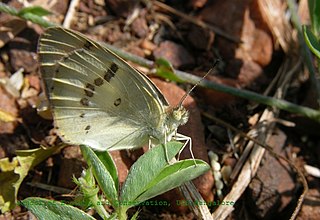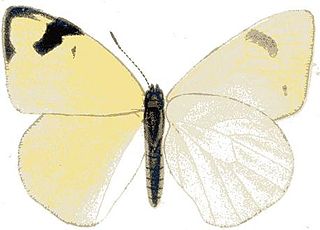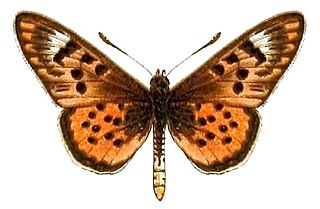
Colotis danae, the crimson tip or scarlet tip, is a small butterfly of the family Pieridae, that is, the yellows and whites. It is found in Asia and Africa.

Colotis, called orange tips or Arabs, is a genus of butterflies of the subfamily Pierinae found mainly in Africa and south-western Asia. The larvae of all Colotis species specialize on plants in the family Capparaceae.

Colotis euippe is a butterfly of the family Pieridae that is found in the Afrotropical realm.

Colotis evagore, the desert orange tip, small orange tip, or tiny orange tip, is a butterfly of the family Pieridae. It is found in the dry parts of tropical Africa, northern Africa, southern Spain and southwest Arabia.

Colotis vesta, the veined tip, veined orange or veined golden Arab, is a butterfly of the family Pieridae. It is found in the Afrotropical realm.

Colotis erone, the coast purple tip, is a butterfly of the family Pieridae. It is found in the Afrotropical realm and is endemic to Natal, Pondoland, Eswatini, and Transvaal.

Colotis regina, the queen purple tip, regal purple tip, or large violet tip, is a butterfly of the family Pieridae. It is found in the Afrotropical realm.

Colotis evenina, the common orange tip, is a butterfly of the family Pieridae. It is found in the Afrotropical realm.

Colotis antevippe, the red tip, is a butterfly of the family Pieridae. It is found in the Afrotropical realm.

Colotis subfasciatus, the lemon tip or lemon traveller, is a butterfly of the family Pieridae. It is found in the Afrotropical realm. The habitat consists of savannah and Brachystegia woodland.

Charaxes doubledayi, Doubleday's untailed charaxes, is a butterfly in the family Nymphalidae. It is found in Sierra Leone, Ivory Coast, Ghana, Togo, Nigeria, Cameroon, Bioko, the Republic of the Congo, the Central African Republic, the Democratic Republic of the Congo and western Tanzania. The habitat consists of lowland tropical evergreen forests. It is a very rare butterfly

Acraea doubledayi is a butterfly in the family Nymphalidae. It is found in Sudan, Uganda, Ethiopia, Somalia, Saudi Arabia and Yemen.












